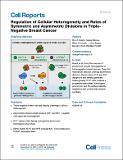Regulation of Cellular Heterogeneity and Rates of Symmetric and Asymmetric Divisions in Triple-Negative Breast Cancer
Author(s)
Granit, Roy Z.; Masury, Hadas; Condiotti, Reba; Fixler, Yaakov; Gabai, Yael; Glikman, Tzofia; Winter, Eitan; Nevo, Yuval; Carmon, Einat; Sella, Tamar; Sonnenblick, Amir; Peretz, Tamar; Lehmann, Ulrich; Paz, Keren; Piccioni, Federica; Ben-Porath, Ittai; Dalin, Simona; Regev, Aviv; Root, David; ... Show more Show less
Download1-s2.0-S2211124718313391-main.pdf (4.081Mb)
PUBLISHER_CC
Publisher with Creative Commons License
Creative Commons Attribution
Terms of use
Metadata
Show full item recordAbstract
Differentiation events contribute to phenotypic cellular heterogeneity within tumors and influence disease progression and response to therapy. Here, we dissect mechanisms controlling intratumoral heterogeneity within triple-negative basal-like breast cancers. Tumor cells expressing the cytokeratin K14 possess a differentiation state that is associated with that of normal luminal progenitors, and K14-negative cells are in a state closer to that of mature luminal cells. We show that cells can transition between these states through asymmetric divisions, which produce one K14+and one K14−daughter cell, and that these asymmetric divisions contribute to the generation of cellular heterogeneity. We identified several regulators that control the proportion of K14+cells in the population. EZH2 and Notch increase the numbers of K14+cells and their rates of symmetric divisions, and FOXA1 has an opposing effect. Our findings demonstrate that asymmetric divisions generate differentiation transitions and heterogeneity, and identify pathways that control breast cancer cellular composition.
Date issued
2018-09Department
Massachusetts Institute of Technology. Department of Biological Engineering; Massachusetts Institute of Technology. Department of BiologyJournal
Cell Reports
Publisher
Elsevier
Citation
Granit, Roy Z., Hadas Masury, Reba Condiotti, Yaakov Fixler, Yael Gabai, Tzofia Glikman, Simona Dalin, et al. “Regulation of Cellular Heterogeneity and Rates of Symmetric and Asymmetric Divisions in Triple-Negative Breast Cancer.” Cell Reports 24, no. 12 (September 2018): 3237–3250.
Version: Final published version
ISSN
22111247